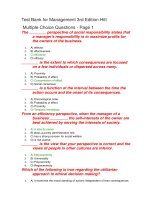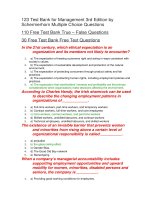Test bank performance management 3rd edition by aguinis chapter 04
Bạn đang xem bản rút gọn của tài liệu. Xem và tải ngay bản đầy đủ của tài liệu tại đây (80.21 KB, 15 trang )
Part II: System Implementation_____________________________________________________________
Chapter 4—Defining Performance and Choosing a Measurement Approach
True/False Questions
4.1
Behaviors that we label as performance can be judged as
negative, neutral, or positive for individual and
organizational effectiveness.
(Suggested points: 2, [4.1])
4.2
Typically, there is only one type of behavior that has the
capacity to advance organizational goals.
(Suggested points: 2, [4.2])
4.3
When the behaviors that contribute to success in a particular
job are not observable, one can include measures of results
that we infer to be the direct result of an employee’s
behavior.
(Suggested points: 2, [4.2])
4.4
Declarative knowledge is information about facts and things,
including an understanding of a given task’s requirements,
information on labels, facts, principles, and goals.
(Suggested points: 2, [4.3])
4.5
The three determinants of performance have an additive
relationship.
(Suggested points: 2, [4.3])
4.6
Performance management systems need to not only measure
performance but also provide information on the source of
any performance deficiencies.
(Suggested points: 2, [4.4])
4.7
Contextual performance is also known as organizational
citizenship or pro-social behavior.
(Suggested points: 2, [4.5])
Copyright © 2013 Pearson Education, Inc. publishing as Prentice Hall
Part II: System Implementation_____________________________________________________________
4.8
Many organizations now realize that there is no need to focus
on both task and contextual performance.
(Suggested points: 2, [4.5])
4.9
Task performance varies across jobs and is likely to be role
prescribed.
(Suggested points: 2, [4.5])
4.10
The fact that there are many ways to deliver effective results
in a job is an indication that a results approach to
performance measurement might be appropriate for the job.
(Suggested points: 2, [4.6])
4.11
The behavior approach to measuring performance
emphasizes the use of tools to assess relatively stable
individual attributes such as cognitive abilities and
personality.
(Suggested points: 2, [4.9])
4.12
The behavior approach is a process-oriented approach that
emphasizes how an employee does the job.
(Suggested points: 2, [4.7])
4.13
When workers are skilled in the needed behaviors, behaviors
and results are related, and results show consistent
improvement over time, it is best to use the results approach
to measuring performance.
(Suggested points: 2, [4.10])
4.14
Contextual factors, such as voice behavior and cultural
differences, should be considered when organizations choose
to define and measure performance.
(Suggested points: 2, [4.6])
Copyright © 2013 Pearson Education, Inc. publishing as Prentice Hall
Chapter 4
Multiple-Choice Questions
4.15
The combination of each of the following factors allows
some individuals to perform at higher levels than others
EXCEPT:
A. Declarative knowledge
B. Procedural knowledge
C. Biases
D. Motivation
(Suggested points: 2, [4.3])
4.16
Procedural knowledge is:
A. Information about facts and things
B. Knowing what to do and how to do it
C. Choosing to expend effort
D. None of the above
(Suggested points: 2, [4.3])
4.17
Motivation involves which of the following behaviors?
A. Choice to expend effort
B. Choice of level of effort
C. Choice to persist in the expenditure of that level of effort
D. All of the above
(Suggested points: 2, [4.3])
4.18
In addition to procedural knowledge, declarative knowledge,
and motivation, ________________ also affect performance.
A. HR practices
B. work environments
C. A and B
D. None of the above
(Suggested points: 2, [4.3])
Copyright © 2013 Pearson Education, Inc. publishing as Prentice Hall
Part II: System Implementation_____________________________________________________________
4.19
Which of the following performance facets must be
considered to understand performance?
A. Task performance and results
B. Declarative knowledge and procedural knowledge
C. Contextual performance and results
D. Task performance and contextual performance
(Suggested points: 2, [4.5])
4.20
Task performance is defined as:
A. Activities that transform raw materials into the goods and
services that are produced by the organization.
B. Activities that help with the transformation process by
replenishing the supply of raw materials.
C. Offering help and cooperating with others.
D. A and B
(Suggested points: 2, [4.5])
4.21
____________________ is defined as those behaviors that
contribute to the organization’s effectiveness by providing a
good environment in which task performance can occur.
A. Contextual performance
B. Results
C. Declarative knowledge
D. Procedural knowledge
(Suggested points: 2, [4.5])
4.22
_________________ performance is fairly similar across
jobs and is not likely to be role prescribed.
A. Task
B. Contextual
C. Exceptional
D. None of the above
(Suggested points: 2, [4.5])
Copyright © 2013 Pearson Education, Inc. publishing as Prentice Hall
Chapter 4
4.23
Which of the following factors are causing organizations to
focus on contextual as well as task performance:
A. Increased amount of teamwork
B. Global competition
C. Customer service
D. Employee perceptions of performance management
E. Supervisors’ views
F. All of the above
G. A, B, and C
(Suggested points: 2, [4.5])
4.24
The __________ approach to measuring performance
emphasizes cognitive abilities and personality.
A. trait
B. results
C. behavior
D. objective
(Suggested points: 2, [4.9)
4.25
The technical definition of performance includes:
A. The employee’s behaviors and the results of the
employee’s behaviors
B. Only the results of the employee’s behaviors
C. Only the employee’s behaviors
D. None of the above
(Suggested points: 2, [4.1])
4.26
Declarative knowledge is:
A. Information that an employee can be tested on
B. Information about facts and things
C. Information that is included in the employee handbook
D. All of the above
(Suggested points: 2, [4.3])
4.27
Procedural knowledge is:
Copyright © 2013 Pearson Education, Inc. publishing as Prentice Hall
Part II: System Implementation_____________________________________________________________
A. Knowing what the boss wants done
B. Knowing how well the job has to be done to “get by”
C. Knowing what to do and how to do it
D. Knowing where all the required equipment are located
(Suggested points: 2, [4.3])
4.28
Declarative knowledge includes which of the following?
A. Facts
B. Psychomotor skill
C. Persistence of effort
D. Cognitive skill
(Suggested points: 2, [4.3])
4.29
Contextual performance and task performance should:
A. Only be considered in higher level employees
B. Be considered as one and the same
C. Be listed in the employee manual
D. Be considered separately
(Suggested points: 3, [4.5])
4.30
The traits approach emphasizes ______________ and ignores
_______________.
A. financial gain; financial loss
B. employee traits; financial loss
C. the individual performer; specific situations, behaviors,
and results
D. specific situations, behaviors, and results; employee traits
(Suggested points: 2, [4.9])
4.31
The behavior approach emphasizes ______________ rather
than _____________.
A. what employees do; employee traits or results
B. employee traits; results
C. results; employee traits
D. None of these are correct
Copyright © 2013 Pearson Education, Inc. publishing as Prentice Hall
Chapter 4
(Suggested points: 2, [4.7])
4.32
Under which of the following conditions would a behavior
approach be most appropriate?
A. Behaviors and results are obviously related.
B. There are many ways to do the job correctly.
C. Results show consistent improvement over time.
D. Outcomes are distant in the future.
(Suggested points: 2, [4.10])
4.33
The results approach emphasizes ______________ rather
than _______________.
A. employee behaviors; results and employee traits
B. outcomes; financial gain
C. employee traits; results and employee behaviors
D. outcomes; employee traits or employee behaviors
(Suggested points: 2, [4.8])
4.34
When results and behaviors are obviously related, which
approach to measuring performance is most appropriate?
A. Trait approach
B. Results approach
C. Behavior approach
D. Orthodox approach
(Suggested points: 2, [4.10])
4.35
When poor results are due to causes beyond the performer’s
control, which approach to measuring performance is most
appropriate?
A. Trait approach
B. Results approach
C. Behavior approach
D. Orthodox approach
(Suggested points: 2, [4.10])
Copyright © 2013 Pearson Education, Inc. publishing as Prentice Hall
Part II: System Implementation_____________________________________________________________
4.36
When employees challenge the status quo in a positive way
and make innovative suggestions for change, they are
exhibiting:
A. Cultural differences
B. Declarative knowledge
C. Psychomotor skills
D. Voice behavior
(Suggested points: 2, [4.6])
Essay-Type Questions
4.37 What are the five steps of deliberate practice that lead to
excellence?
(Suggested points: 2, [4.3])
4.38 Performance consists of both task and contextual dimensions.
Please define each type of performance, and explain whether
companies should focus on task performance, contextual
performance, or a combination of both.
(Suggested points: 2, [4.5])
4.39 Using your current work situation, or one of someone you
know well, describe whether performance is measured using
a trait, behavior, or results approach. Use the checklist below
to identify whether or not your company should measure
performance using the trait, behavior, or results method.
Adopting a Traits Approach to Measuring Performance
Is Most Appropriate When …
The organization is undertaking a drastic structural
change
Adopting a Behavior Approach to Measuring
Performance Is Most Appropriate When …
Employees will take a long time to achieve the
desired outcomes
The link between behaviors and results is not
obvious
Copyright © 2013 Pearson Education, Inc. publishing as Prentice Hall
Chapter 4
Outcomes are distant in the future
Poor results are due to causes beyond the
performer’s control
Adopting a Results Approach to Measuring Performance
Is Most Appropriate When …
Workers are skilled in the needed behaviors
Behaviors and results are obviously related
Results show consistent improvement over time
There are many ways to do the job right
Is this approach appropriate given your job responsibilities
and the climate of the organization? Explain whether or
not you think that the system could be improved using a
different approach to measuring performance.
(Suggested points: 3, [4.10])
4.40 What are the three determinants of performance that allow
some people to perform at higher levels than others?
(Suggested points: 2, [4.3])
4.41
Motivation involves three types of choice behaviors. What are they?
(Suggested points: 2, [4.3])
4.42
What is the expected outcome if any of the determinants of performance
are lacking?
(Suggested points: 5, [4.3])
4.43
The factors that influence determinants of performance are influenced by
what three things?
(Suggested points: 5, [4.3])
4.44
Activities that transform raw materials into goods and services that are
produced by an organization are called …
(Suggested points: 2, [4.5])
4.45
Activities that help with the transformation process by replenishing the
supply of raw materials, distributing its finished products, or providing important
planning, coordination, or supervision are called …
(Suggested points: 2, [4.5])
Copyright © 2013 Pearson Education, Inc. publishing as Prentice Hall









